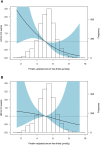Systemic Oxidative Stress, Aging and the Risk of Cardiovascular Events in the General Female Population
- PMID: 33634173
- PMCID: PMC7900172
- DOI: 10.3389/fcvm.2021.630543
Systemic Oxidative Stress, Aging and the Risk of Cardiovascular Events in the General Female Population
Abstract
Introduction: Menopause is associated with increased cardiovascular risk, in which oxidative stress plays a pivotal role. Systemic oxidative stress is reflected by decreased levels of free thiols (R-SH, sulfhydryl groups), which are key components of the extracellular antioxidant machinery. In this study, we investigated the relation between serum free thiols as marker of oxidative stress and the female cardiovascular phenotype, as well as potential associations with the risk of cardiovascular (CV) events in pre- and postmenopausal women from the general population. Methods: Female participants (n = 2,980) of the Prevention of REnal and Vascular ENd-stage Disease (PREVEND) cohort study were included. Serum free thiol concentrations were analyzed for associations with demographic, clinical, biochemical, and gynecological parameters, as well as with menopausal status and, prospectively, with the risk of CV events. Results: Postmenopausal women had significantly reduced levels of serum free thiols (4.8 ± 1.0 vs. 5.2 ± 1.0 μmol/g, P < 0.001) compared to reproductive women. In multivariable analyses, serum free thiols were significantly associated with menopausal status (OR 0.70 [0.49-0.98], P = 0.039), even when adjusted for potential confounding factors, except for age (P = 0.550). Prospectively, serum free thiols were significantly associated with the risk of CV events (HR 0.52 [0.27-0.97], P = 0.040), even with covariate adjustment, although this disappeared when correcting for age. Conclusion: In this study, we revealed serum free thiols to be strongly associated with the female cardiovascular phenotype as well as with female risk of CV events, where the influence of age itself seemed to outweigh that of female menopause. Future studies are warranted to further unravel the clinical utility of serum free thiol levels in the context of female cardiovascular risk management.
Keywords: cardiovascular events; free thiols; menopause; oxidative stress; population study.
Copyright © 2021 Bourgonje, Bourgonje, Abdulle, Kieneker, la Bastide-van Gemert, Gansevoort, Bakker, Mulder, Pasch, Saleh, Gordijn and van Goor.
Conflict of interest statement
The authors declare that the research was conducted in the absence of any commercial or financial relationships that could be construed as a potential conflict of interest.
Figures




Similar articles
-
Serum free thiols predict cardiovascular events and all-cause mortality in the general population: a prospective cohort study.BMC Med. 2020 May 27;18(1):130. doi: 10.1186/s12916-020-01587-w. BMC Med. 2020. PMID: 32456645 Free PMC article.
-
Systemic Oxidative Stress Is Increased in Postmenopausal Women and Independently Associates with Homocysteine Levels.Int J Mol Sci. 2020 Jan 2;21(1):314. doi: 10.3390/ijms21010314. Int J Mol Sci. 2020. PMID: 31906485 Free PMC article.
-
Serum free sulfhydryl status associates with new-onset chronic kidney disease in the general population.Redox Biol. 2021 Dec 9;48:102211. doi: 10.1016/j.redox.2021.102211. Online ahead of print. Redox Biol. 2021. PMID: 34896941 Free PMC article.
-
Cardiovascular events among reproductive and menopausal age women with polycystic ovary syndrome: a systematic review and meta-analysis.Gynecol Endocrinol. 2020 Jan;36(1):12-23. doi: 10.1080/09513590.2019.1650337. Epub 2019 Aug 6. Gynecol Endocrinol. 2020. PMID: 31385729
-
What the Women's Health Initiative has taught us about menopausal hormone therapy.Clin Cardiol. 2018 Feb;41(2):247-252. doi: 10.1002/clc.22891. Epub 2018 Mar 1. Clin Cardiol. 2018. PMID: 29493798 Free PMC article. Review.
Cited by
-
Impact of midazolam on salivary glands: a comprehensive analysis of oxidative biochemistry, morphological changes, and salivary composition.Naunyn Schmiedebergs Arch Pharmacol. 2025 Jul 22. doi: 10.1007/s00210-025-04447-7. Online ahead of print. Naunyn Schmiedebergs Arch Pharmacol. 2025. PMID: 40694094
-
Oxidative Stress and Menopausal Status: The Coronary Artery Risk Development in Young Adults Cohort Study.J Womens Health (Larchmt). 2022 Jul;31(7):1057-1065. doi: 10.1089/jwh.2021.0248. Epub 2022 Jun 8. J Womens Health (Larchmt). 2022. PMID: 35675673 Free PMC article.
-
12 Weeks of Physical Exercise Attenuates Oxidative Stress, Improves Functional Tests Performance, and Reduces Fall Risk in Elderly Women Independently on Serum 25(OH)D Concentration.Front Physiol. 2022 Apr 20;13:809363. doi: 10.3389/fphys.2022.809363. eCollection 2022. Front Physiol. 2022. PMID: 35514345 Free PMC article.
-
Association Between Riboflavin Intake and Telomere Length: A Cross-Sectional Study From National Health and Nutrition Examination Survey 1999-2002.Front Nutr. 2022 Mar 31;9:744397. doi: 10.3389/fnut.2022.744397. eCollection 2022. Front Nutr. 2022. PMID: 35433791 Free PMC article.
-
Alteration of the aortic vascular reactivity associated to excessive consumption of Hibiscus sabdariffa Linnaeus: Preliminary findings.Heliyon. 2023 Sep 9;9(9):e20020. doi: 10.1016/j.heliyon.2023.e20020. eCollection 2023 Sep. Heliyon. 2023. PMID: 37810051 Free PMC article.
References
-
- Cortese-Krott MM, Koning A, Kuhnle GGC, Nagy P, Bianco CL, Pasch A, et al. . The reactive species interactome: evolutionary emergence, biological significance, and opportunities for redox metabolomics and personalized medicine. Antioxid Redox Signal. (2017) 27:684–712. 10.1089/ars.2017.7083 - DOI - PMC - PubMed
LinkOut - more resources
Full Text Sources
Other Literature Sources

